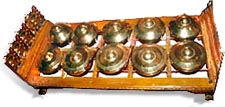| Music and dance are almost inseparable in the
Malaysian culture. Where there is one, the other is not
far behind. True to Malaysia's heritage, dances vary
widely and are, if not imports direct from the Traditional music is centered around the gamelan, a stringed instrument from Indonesia with an otherworldly, muffled sound. The lilting, hypnotic beats of Malaysian drums accompany the song of the gamelan; these are often the background for court dances. Malaysia's earliest rhythms were born of necessity. In an age before phone and fax, the rebana ubi, or giant drums, were used to communicate from hill to hill across vast distances. Wedding announcements, danger warnings, and other newsworthy items were drummed out using different beats. The rebana ubi are now used primarily as ceremonial instruments. The Giant Drum Festival is held in Kelantan either in May or June. Similarly, silat, an elegant Malaysian dance form, originated as a deadly martial art. The weaponless form of self-defense stripped fighting to a bare minimum. Silat displays are common at weddings and other festivals; the dancer will perform sparring and beautiful routines to accompanying drums and other musical instruments. The candle dance is one of Malaysia's most
breathtakingly beautiful performance arts. The Joget, Malaysia's most popular traditional dance, is a lively dance with an upbeat tempo. Performed by couples who combine fast, graceful movements with rollicking good humor, the Joget has its origins in the Portuguese folk dance, which was introduced to Malacca during the era of the spice trade. Among the many different traditional theatres of the Malays, which combine dance, drama, and music, no other dance drama has a more captivating appeal than Mak Yong. This ancient classic court entertainment combines romantic stories, operatic singing and humor. The Datun Julud is a popular dance of Sarawak, and illustrates the age-old tradition of storytelling in dance. The Datun Jalud tells of the happiness of a prince when blessed with a grandson. It was from this divine blessing that the dance became widespread among the Kenyah tribe of Sarawak. The Sape, a musical instrument, renders the dance beats, which are often helped along by singing and clapping of hands.
|
The Original Official Homepage
of the This page, and all contents of this Web site are
Copyright (c) 1996-2002 by interKnowledge Corp.. |
 source nation, heavily influenced by one
or more of Malaysia's cultural components. Much of
Malaysian music and dance has evolved from more basic
needs into the mesmerizing, complex art forms they are
today.
source nation, heavily influenced by one
or more of Malaysia's cultural components. Much of
Malaysian music and dance has evolved from more basic
needs into the mesmerizing, complex art forms they are
today. Candles on small plates are held in each
hand as the dancer performs. As the performer's body
describes graceful curves and arcs, the delicate candle
flames become hypnotic traces.
Candles on small plates are held in each
hand as the dancer performs. As the performer's body
describes graceful curves and arcs, the delicate candle
flames become hypnotic traces. Although Malaysia's cultural heritage is
rich and varied almost beyond belief, it would be a
mistake to assume that heritage to be wholly traditional.
Malaysia has joined the recent world music trend by
updating many of its beautiful traditional sounds. Modern
synthesizers accompany the gamelan and the drums for a
danceable, hypnotic sound you won't soon forget.
Although Malaysia's cultural heritage is
rich and varied almost beyond belief, it would be a
mistake to assume that heritage to be wholly traditional.
Malaysia has joined the recent world music trend by
updating many of its beautiful traditional sounds. Modern
synthesizers accompany the gamelan and the drums for a
danceable, hypnotic sound you won't soon forget.